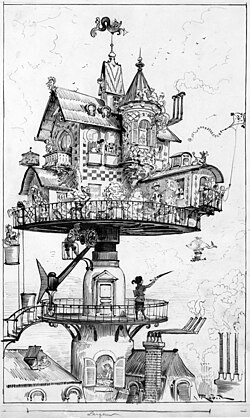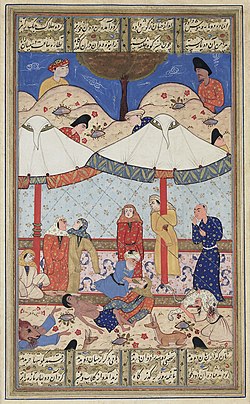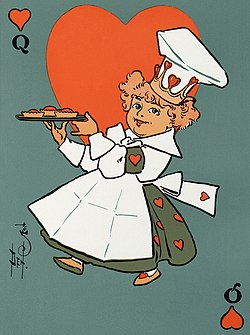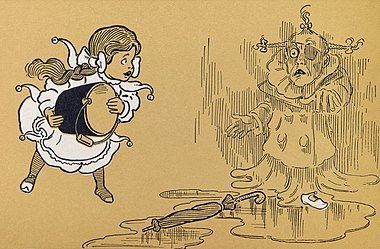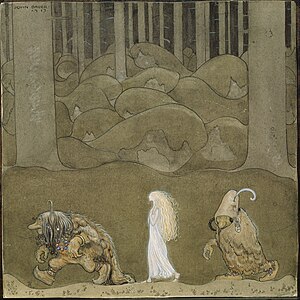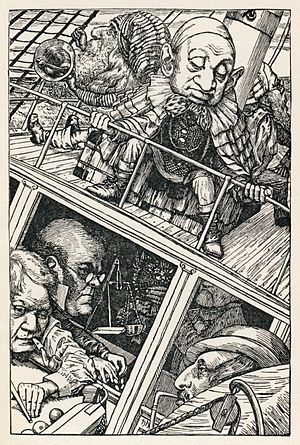The Selected picture box on the portal chooses one of the following at random when displaying the page. Follow the instructions below for adding or nominating a new picture to the list.
Feel free to add related featured pictures to the list. Nominate other pictures on the portal talk page.
- Pictures must be
- Free to use and hosted on Commons
- Of good quality (not blurred, grainy or discoloured)
- Interesting
- Relevant to an article or topic
To find appropriate pictures, use search box below:
- For pictures, which appeared as picture of the day on the Main Page, just add the date in
YYYY-MM-DD format to the list (please keep the list sorted).
- For other pictures, use following parameters:
|iN=
|titleN=
|creditN=
|captionN=
where N is the next unused number.
Selected pictures list
[edit]Template:POTD/2008-05-25
This
woodblock print, titled
Kinhyōshi yōrin, hero of the Suikoden, is one of a series created by the
Japanese artist Utagawa Kuniyoshi between 1827 and 1830 illustrating the 108
Suikoden ("Water Margin"). The publication of the series catapulted Kuniyoshi to fame. The story of the Suikoden is an adaptation of the Chinese
Shuǐhǔ Zhuàn; during the 1800s, the publication of this woodblock series and other translations of the novel created a Suikoden craze in Japan. Following the great commercial success of the Kuniyoshi series, other
ukiyo-e artists were commissioned to produce prints of the Suikoden heroes, which began to be shown as Japanese heroes rather than the original Chinese personages. The hero portrayed in this print is
Yang Lin.
Template:POTD/2008-10-28
Sir
John Tenniel's illustration of the
Caterpillar for
Lewis Carroll's classic children's book,
Alice's Adventures in Wonderland. The illustration is noted for its ambiguous central figure, which can be viewed as having either a human male's face with pointed nose and protruding lower lip or as the head end of an actual
caterpillar, with the right three "true" legs visible. The small symbol in the lower left is composed of Tenniel's initials, which was how he signed most of his work for the book. The partially obscured word in the lower left-center is the last name of Edward Dalziel, the
engraver of the piece.
Template:POTD/2009-04-01
A typical 20th-century aerial rotating house, as drawn by
Albert Robida. The drawing shows a dwelling structure in the
scientific romance style elevated above rooftops and designed to revolve and adjust in various directions. An occupant in the lower right points to an
airship with a fish-shaped balloon in the sky, while a woman rides a bucket
elevator on the left. Meanwhile, children fly a
kite from the balcony as a dog watches from its rooftop
doghouse.
Template:POTD/2009-08-15
An illustration from the first edition of
The Wonderful Wizard of Oz, depicting the scene where
Dorothy meets the
Cowardly Lion, the first time the four major characters of the novel come together. The book was originally published in 1900 and has since been reprinted countless times, most often under the name
The Wizard of Oz, which is the name of both the 1902 Broadway
musical and the extremely popular, highly acclaimed
1939 film version. Thanks in part to the film it is one of the best-known stories in American popular culture and has been widely translated. Its initial success, and the success of the popular 1902 musical Baum adapted from his story, led to his writing and having published thirteen more
Oz books.
Template:POTD/2009-09-27
Template:POTD/2009-12-04
A scene from a late-16th century publication of
Nezami Ganjavi's adaptation of the classical
Persian story
Layla and Majnun, which is based on the real story of Qays ibn al-Mulawwah, a young man from the northern
Arabian Peninsula and his love Layla. There are two versions of the story, but in both, Majnun goes mad when her father prevents him from marrying her. In the depicted scene, the eponymous
star-crossed lovers meet for the last time before their deaths. Both have fainted and Majnun's elderly messenger attempts to revive Layla while wild animals protect the pair from unwelcome intruders.
Template:POTD/2010-01-28
Artist: George Pickering, Engraver: William Greatbatch; Restoration: Adam Cuerden One of the two earliest illustrations of
Jane Austen's novel
Pride and Prejudice, which was first published on January 28, 1813. This
engraving comes from the first illustrated edition, published twenty years later, and depicts
Elizabeth Bennet (the main protagonist, right) and her father, in
fashions that were common in the 1830s, not the story's original time setting. The novel is told from Bennet's point of view and deals with issues of
manners,
upbringing,
moral rightness,
education and
marriage in the aristocratic society of early
19th century England. The novel retains a fascination for modern readers, having sold some 20 million copies worldwide and continuing near the top of lists of 'most loved books'.
Template:POTD/2010-02-14
Template:POTD/2010-03-20
An illustration from a ca. 1916 edition of
The Water-Babies, A Fairy Tale for a Land Baby, a
children's novel written by
Charles Kingsley and originally
serialised in 1862–63. The book, a
didactic moral
fable, tells the story of Tom (lower left), a young boy who drowns and is
reincarnated as a "water-baby". He undergoes a series of adventures and eventually regains his human form. It was extremely popular during its day and through the 1920s, but has since fallen out of favour, perhaps due to Kingsley's expression of many of the common
prejudices of that time period, such as against
Americans,
Jews,
blacks, and
Catholics, particularly the
Irish.
Template:POTD/2010-05-17
Dorothy (left) douses the
Wicked Witch of the West with water, melting her, in this illustration from the first edition of
L. Frank Baum's
The Wonderful Wizard of Oz. The appearance of the witch in the
1939 film adaptation of the novel has become an
archetype for human wickedness. This film is the source of the oft-quoted phrase, "I'll get you, my pretty ... and your little dog too!" The unique Broadway musical, Wicked, The Untold Story Of the Witches of Oz, tells of The Wicked Witch of the West, the Tin Man, The Cowardly Lion, The Scarecrow, and Glinda's shared history.
Template:POTD/2010-06-07
Template:POTD/2010-06-19
In this scene from
Laurence Sterne's
The Life and Opinions of Tristram Shandy, Gentleman, Uncle Toby's colonel invents a device for firing multiple miniature
cannons at once, based on a
hookah. Unfortunately, he and Toby find the puffing on the hookah pipe so enjoyable that they keep setting the cannons off. The novel was published in nine volumes over ten years, starting in 1759. Although it was not always held in high esteem by other writers, its bawdy humour was popular with London society, and it has come to be seen as one of the greatest
comic novels in English, as well as a forerunner for many modern narrative devices and styles.
Template:POTD/2010-07-10
Template:POTD/2010-08-15
"Le Noir Faineant in the Hermit's Cell", an illustration from an 1886 edition of Sir
Walter Scott's 1819 novel
Ivanhoe. Here, we see Le Noir Faineant, or the Black Knight (
Richard the Lionheart in disguise) with
Friar Tuck. Scott was an early pioneer in the development of the modern novel, and largely created the genre of
historical fiction by weaving together legends and characters into his own creations.
Ivanhoe, the story of one of the remaining
Saxon noble families at a time when the English nobility was overwhelmingly
Norman, was greatly influential on the modern view of the English
folk hero Robin Hood, and has inspired many adaptations around the world in theatre, opera, film, and television.
Template:POTD/2010-09-29
An engraving by
Gustave Doré of a scene from
Miguel de Cervantes's
Don Quixote, the most influential work of literature from the
Spanish Golden Age in the Spanish literary canon. The scene illustrated here occurs early in the novel, when Alonso Quixano (Quixote's real name) has become obsessed with books of
chivalry, and believes their every word to be true, despite the fact that many of the events in them are clearly impossible.
Don Quixote was published in two separate volumes, ten years apart. It is considered a founding work of modern
Western literature, and it regularly appears high on lists of the greatest works of fiction ever published.
Template:POTD/2010-10-17
An illustration from an 1893 version of
A Wonder-Book for Girls and Boys by
Nathaniel Hawthorne, which recounted the tale of
King Midas. In
Greek mythology, Midas was given ability to turn everything he touched into
gold by the god
Bacchus. However, he soon discovered that he was unable to even eat. Bacchus told him to wash in the river
Pactolus, and the power flowed in the river, which was supposedly the reason for why the river was so rich in gold in later years. In Hawthorne's version, Midas' touch even turned his daughter to gold (pictured here).
Template:POTD/2010-11-24
A scene from
Chapter XXVII of
Guy Mannering, a
historical novel by Sir
Walter Scott that was originally published
anonymously in 1815. It is set in the 1760s to 1780s, mostly in the
Galloway area of southwest
Scotland. The eponymous character of Guy Mannering is actually only a minor character in the story, the plot being mostly concerned with Harry Bertram, the son of the
Laird of Ellangowan, who is kidnapped at the age of five by
smugglers. It follows the fortunes and adventures of Harry and his family in subsequent years, and the struggle over the inheritance of Ellangowan. The novel also depicts the lawlessness that existed at the time, when smugglers operated along the coast and thieves frequented the country roads. The book was a huge success, selling out the day after its first edition.
Template:POTD/2010-12-10
A scene from Sir
Walter Scott's 1817
historical novel Rob Roy, which tells the story of Frank Osbaldistone, the son of an English merchant who travels to Scotland to collect a debt stolen from his father. On the way he encounters the larger-than-life title character of
Robert Roy MacGregor. Though Rob Roy is not the lead character (in fact the narrative does not move to Scotland until halfway through the book) his personality and actions are key to the story's development. The novel is a brutally realistic depiction of the social conditions in
Highland and
Lowland Scotland in the early 18th century.
Template:POTD/2010-12-15
A scene from "
The Canterville Ghost",
Oscar Wilde's first published story, which is about an American family that moves into a
haunted house in England. However, instead of being frightened of the eponymous
ghost, they turn the tables and prank him, such as in this scene, where the twin boys have set up a
butter-slide, causing the ghost to slip down the staircase. The story satirises both the unrefined tastes of Americans and the determination of the British to guard their traditions.
Template:POTD/2011-01-03
A scene from
Oscar Wilde's 1895 play
An Ideal Husband, originally published in a 1901 collected edition of Wilde's works. The
comedy, which opened
January 3, 1896, at the
Haymarket Theatre in
London, revolves around
blackmail and
political corruption, and touches on the themes of public and private
honour. It has been adapted into television, radio/audio, and three films. The published version differs slightly from the performed play, for Wilde added many passages and cut others. Prominent additions included written
stage directions and character descriptions. Wilde was a leader in the effort to make plays accessible to the reading public.
Template:POTD/2011-04-03
The
frontispiece to a c. 1825 edition of
Childe Harold's Pilgrimage, a lengthy
narrative poem by
Lord Byron. The poem describes the travels and reflections of a world-weary young man who, disillusioned with a life of pleasure and revelry, looks for distraction in foreign lands. In a wider sense, it is an expression of the melancholy and disillusionment felt by a generation weary of the wars of the post-Revolutionary and
Napoleonic eras. This poem proved to be quite popular upon its publication in 1812. Byron himself said of this, "I awoke one morning and found myself famous."
Template:POTD/2011-05-08
Hermann Vezin in the title role of
Dan'l Druce, Blacksmith, an 1876 play by
W. S. Gilbert. In the story, Druce begins as a miser and drunkard whose wife has left him. Two army
deserters find shelter at his house, but they rob him and abandon a baby girl there. Many years later, Druce has become a
blacksmith, and the two men return to try to claim the girl. The play was a success, running for about 100 performances and enjoying tours and several revivals.
Template:POTD/2012-03-23
An illustration of
Humpty Dumpty by American artist
William Wallace Denslow, depicting the title character from the
nursery rhyme of the same name. He is typically portrayed as an egg, although the rhyme never explicitly states that he is, possibly because it may have been originally posed as a
riddle. The earliest known version is in a manuscript addition to a copy of
Mother Goose's Melody published in 1803.
Template:POTD/2012-09-05
The wolf blows down the straw house in a 1904 adaptation of
Three Little Pigs, a
fairy tale featuring
anthropomorphic animals. Printed versions date back to the 1840s, but the story itself is thought to be much older. The story in its arguably best-known form appeared in
English Fairy Tales by
Joseph Jacobs, first published in 1890. The phrases used in the story, and the various morals which can be drawn from it, have become embedded in western culture. The story uses the literary
rule of three, expressed in this case as a "contrasting three", as the third pig's brick house turns out to be the only one which is adequate to withstand the wolf.
Template:POTD/2012-11-28
Template:POTD/2013-12-30
An illustration from the story "Young Men at the Manor" from the first printing of
Rudyard Kipling's 1906 fantasy book
Puck of Pook's Hill, featuring the legend "'Sir Richard, will it please you enter your Great Hall?'".
The book consists of a number of stories, all narrated to two children living near Burwash, in the area of Kipling's own house Bateman's, by people magically plucked out of history by the elf Puck, or told by Puck himself.
See another illustration
Template:POTD/2014-02-25
Template:POTD/2014-05-15
"
The Sleeping Beauty" is a poem written by
Alfred, Lord Tennyson, and published in 1830; it was later expanded and published in 1842 as "The Day-Dream". Based on the fairy tale
Sleeping Beauty, the poem (as with many of Tennyson's adaptations of existing literary works) focuses on a single aspect of the story, the appearance of the eponymous character as she sleeps.
This illustration by
W. E. F. Britten was published in 1901 to accompany a reprinting of "The Sleeping Beauty". It accompanies the poem's final lines: "She sleeps, nor dreams, but ever dwells / A perfect form in perfect rest."
Template:POTD/2014-06-05
The Song of Los is an epic poem by
William Blake first published in 1795 and considered part of his
prophetic books. The poem consists of two sections, "Africa" and "Asia": in the first section Blake catalogues the decline of morality in Europe, which he blames on both the African slave trade and enlightenment philosophers, whereas in the second section he describes a worldwide revolution, urged by the eponymous
Los.
The illustration here is from the book's
frontispiece and shows
Urizen presiding over the decline of morality.
Template:POTD/2014-12-31
A mid-19th century illustration for "
Auld Lang Syne", a
Scots poem written by
Robert Burns in 1788 and set to a traditional melody. It is traditionally used in the English-speaking world to bid farewell to the old year at the stroke of midnight on
New Year's Eve; this has led to the song being used to close other activities as well.
Template:POTD/2016-04-21
Template:POTD/2017-04-01
Template:POTD/2017-06-19
A watercolor illustration by
John Bauer (1882–1918) titled "Still, Tuvstarr sits and gazes down into the water", which accompanied Helge Kjellin's fairy tale "The Tale of the Moose Hop and the Little Princess Cotton Grass" in the 1913 edition of
Among Gnomes and Trolls. In this scene, Tuvstarr looks for her lost heart in a
tarn, symbolizing innocence lost.
Born and raised in
Jönköping, Sweden, Bauer moved to
Stockholm at age 16 to study at the
Royal Swedish Academy of Fine Arts. He painted and illustrated in a
romantic nationalistic style, in part influenced by the Italian
Renaissance and
Sami cultures. Most of his works are
watercolors or prints in monochrome or muted colours; he also produced oil paintings and
frescos.
Template:POTD/2017-11-28
Template:POTD/2018-04-08
Template:POTD/2018-12-01
The Princess and the Trolls, by
John Bauer (1882–1918), was painted as an illustration for "The Changeling", a short story by
Helena Nyblom. A
watercolour held by the
Nationalmuseum in
Stockholm, it was first published in the 1913 edition of the anthology
Among Gnomes and Trolls. It shows the princess
Bianca Maria between two trolls in a forest. Bauer's illustrations of fairy tales and children's stories made him a household name in his native Sweden, and shaped perceptions of many fairy tale characters.
Template:POTD/2019-01-10
Template:POTD/2019-04-08
Rootabaga Stories is a children's book of interrelated short stories by
Carl Sandburg, written in 1922. The stories are whimsical and sometimes melancholy, making use of nonsense language.
Rootabaga Stories was originally created for Sandburg's own daughters, Margaret, Janet and Helga—whom he nicknamed "Spink", "Skabootch", and "Swipes"—and those nicknames occur in some of the Rootabaga stories. The book was born of Sandburg's desire for fairy tales to which American children could relate, rather than the traditional European stories involving royalty and knights. He therefore set the book in a fictionalized
American Midwest called the "Rootabaga country", in which fairy-tale concepts were mixed with trains, sidewalks, and skyscrapers.
This picture shows the frontispiece of the 1922 edition of the book.
Template:POTD/2020-11-14
The Hunting of the Snark is a poem composed by the English writer
Lewis Carroll between 1874 and 1876, typically characterised as a
nonsense poem. The plot follows a crew of ten who cross the ocean to hunt the
Snark, which may turn out to be a highly dangerous Boojum. This is the second of
Henry Holiday's original illustrations for the first edition of the poem. It introduces some of the crew, whose names all start with "B"; the Bellman and Baker are on the upper deck, with the Barrister seated in the background; below are the Billiard-marker, the Banker and the Broker, with the maker of Bonnets and Hoods visible behind.
Template:POTD/2021-04-08
The Hunting of the Snark is a nonsense poem written by English writer
Lewis Carroll between 1874 and 1876. The plot follows a crew of ten trying to hunt the
Snark, which may turn out to be a highly dangerous Boojum. This original illustration by
Henry Holiday accompanies the verse:
"But oh, beamish nephew, beware of the day,
If your Snark be a Boojum! For then
You will softly and suddenly vanish away,
And never be met with again!"



